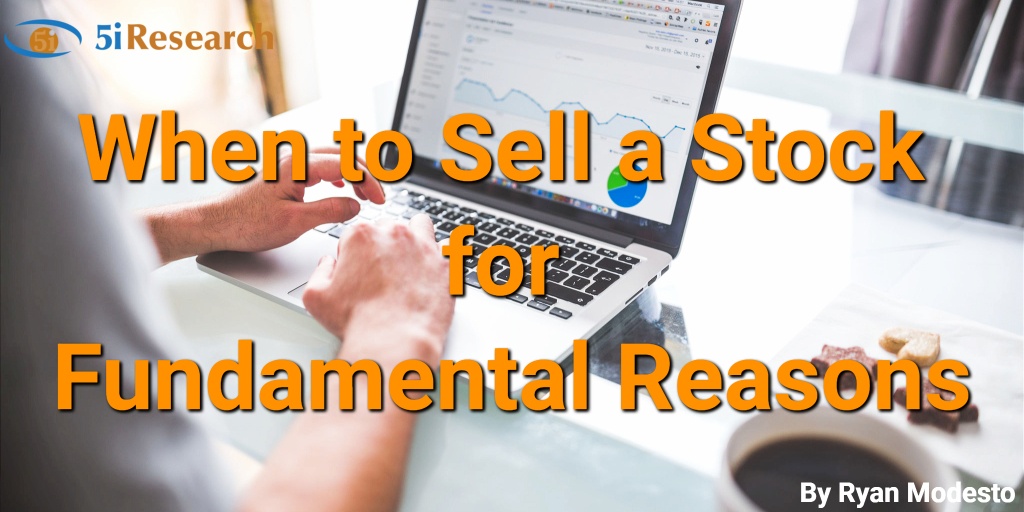
Previously we looked at selling a stock based on portfolio decisions. If you missed it, we would consider starting with this article here before reading this one.
When to sell a stock is one of the toughest questions for an investor to answer. It involves emotions, money and oftentimes ego. All of these aspects can be tough to manage so setting up some rules on when selling a stock is appropriate can make sense. So, let us take a view of when to sell for stock-specific reasons to help make the difficult decision a bit easier.
It is important to keep in mind that these reasons to sell are not all-encompassing nor is it necessarily the ‘right’ answer to the question. It is what I have come to find works for me over time though and may or may not work for others.
One key caveat when reading this is that the overarching answer to when to sell is that you should likely sell a lot less than you do already. Oftentimes investors get ‘scared’ out of a position on a random, immaterial piece of news or sell a stock because everything is going well and there is a gain. Selling a stock that is doing well on average could be the biggest mistake an investor makes. It goes against momentum, as well as involves selling a stock that is going up for a reason: the business results or prospects looked good. Why would you sell something where everything is going right?
So as one goes through the selling process, the first question to ask if it actually needs to be sold at all. Additionally, this does not even get into complications such as taxes, transaction costs and being able to reinvest the money.
So to repeat, often the answer to selling a stock is simply “no”. But alas, there are times an investor does indeed need to sell a stock, and this is what I think constitutes a reason to sell. The biggest mistake can be selling a stock that is up outside of portfolio reasons, and is doing well because good things are happening.
When the story has changed
Typically when someone invests in a stock, there is some sort of narrative that goes along with it. ‘Stock X is a first mover in a new and growing industry’, or ‘Stock Y has a significant market share protected by long-term contracts’, etc. This is probably not the only reason for owning the company but would essentially be the glue that holds the whole thesis together because if an investment does not make sense at a high level, it is probably not going to make sense when you dig down into the opportunity.
So if this story for why one initially purchased a stock has changed for the worse, it probably means it is time to sell. If the overarching reason behind the purchase has changed, so too should the lens you approach it with. A good way to keep track of why you first purchased a security is to keep some sort of journal or spreadsheet that keeps you honest (See 'Why Writing is Important When Investing’). This way an investor can look back at it, remember the reasoning behind the purchase and see if that ‘story’ has changed.
When the fundamentals have changed
You could probably do a whole write-up on this section on its own but if an investment was initially made on the merits of the fundamentals, it stands to reason that once those fundamentals change, it is time to consider selling a stock. We think there are a few buckets to focus on:
- Revenue growth – If revenue growth slows or declines, it might be time to sell. This means ‘something’ in the business is changing. Customers don’t want the products, competition is increasing or pricing is improper. Regardless, declining revenues is a sign that things may be moving in the wrong direction.
- Leverage picture changes – One of the main things that can bring a company down is leverage. So, if a company goes from a low debt load to a high one, the risks have increased and this may be an indicator that it is time to sell. The company with lots of debt is no longer the one that you initially purchased.
- Dividend picture changes – If a dividend grower shifts to a high dividend payer, this could signal it has matured and growth has slowed. If the yield has grown on declining results, this could be a hint that something is going wrong in the business. Or if the payout ratio goes from low to high, the safety of that dividend has changed. All of these may not be reasons to sell outright, but warrant a look at if the reason it was initially purchased still exists.
- Compressing margins – Might be getting a little too in the weeds here but if this becomes a trend, there could be an issue in the business between increased competition, increased costs or some sort of disconnect in the operations.
When it becomes too small for investors to care anymore
This is probably the closest to selling a stock ‘because it is down’ as we will get. Often times if a stock gets too small, investors just stop caring. The issue is twofold where since it is smaller, that means investors have lost a money on it, are looking to sell and will be once burned twice shy.
The other issue is that if it falls past a certain threshold, it means that certain investors will be unable to invest in the security. Many larger investors need to follow mandates where they can only hold stocks of a certain size. If they held it before but it fell past a threshold, they will not be around to support it like they could have in the past.
When you are wrong
This one sounds obvious but could be one of the harder conclusions to come too. Egos and emotions are a big part of investing. One of the great, humbling and frustrating things about it is that no matter what your reasoning or logic was, you get two finite, measurable outcomes: Stock goes up, you were right. Stock goes down, you were wrong. No one cares if you were wrong for the right reasons. However, since selling is often an admission of being wrong, investors look for reasons why they are right. So, if you find you are looking for all of these other reasons to justify why you should still hold a losing stock, none of which align with the original reasons, it could mean that the thesis was just incorrect and it is time to move on.
When there’s too much drama surrounding a stock and/or it has become too volatile
We often get questions from members about stocks that are in the headlines. A company maybe had a bad quarter, is under regulatory scrutiny or short sellers are piling on. The allure of a stock that is 25% ‘cheaper’ than yesterday is easy to understand. However, we view this often as a time to simply sell and move on. There are plenty of fish in the sea and an investor does not need to hang around with the headline risk, drama, stress, volatility and uncertainty of stocks caught up in a news cycle.
There is money to be made in these types of names most certainly, but that is for a higher risk more speculative investor. We would far prefer to sit on the sidelines in these situations and avoid the news cycle and watch the drama for fun as opposed to having capital at risk.
In the case of volatility, if a name is jumping by 5% or more any given day, it is tough to call it an ‘investment’ any more as it becomes more of a bet on a given day’s move. Again, some investors will make money here but we would far prefer to look elsewhere at this stage.
Valuation
Selling on valuation is a bit less of a straightforward discussion when it comes to selling. As a general rule, I do think investors are a bit too quick to sell a stock just because it ‘looks’ expensive, without taking into consideration why a stock might be expensive.
There are limits to this though where sometimes it is just too difficult to get to a place where a valuation can be justified. What I am more focused on here though in the context as a signal to sell, is when there is a transition in valuation.
An example of this is a company we cover at 5i Research called Savaria (TSX: SIS). We started covering SIS at a positive rating at a price of $5.16. At the time, it was cheap on most if not all metrics, yielded 4% and was small. Fast-forward to today and it is now trading just shy of $18, with an expensive valuation and a 2% yield. Mind you the growth prospects are arguably better than before and more certain, but this is besides the point.
So initially Savaria was interesting because it was cheap and growing with a dividend. One of the attractive factors is now gone though as the trading multiple has expanded. So, the type of investor that initially purchased SIS may not be very comfortable with the stock it is today. In our case, with more of a growth bias, we remained comfortable with the stock and actually increased the rating as it was rising in value, but for many investors, there could have been a case for selling the shares.
An investor who buys a value stock that remains a value stock and a growth investor that buys a growth stock that remains so will not see much dissonance in their investment style. However, when stocks transition from value to growth or vice-versa, something has changed and the investor needs to come to terms with it. We think it is less of a clear sell signal when this happens, but there has still been something fundamental to the thesis that has changed, and at this point, the investor at least needs to reexamine the thesis here.
When an industry/company/product/service get supplanted or becomes obsolete
This is another item that may sound obvious, but in practice is less clear. Often times a whole industry can face an existential threat where the world has changed and left a company or industry behind. The Internet has been a primary culprit in many instances over the last 10 or 20 years. However, when a company faces a dwindling industry outlook, this often means shares fall but the valuation gets very cheap. This, of course, attracts deep value investors who think a stock trading below book value might be a steal.
There can be potential with this strategy but there are swathes of investors who have lost money by trying to catch falling knives or call the bottoms on industries in decline. Ideas like “a stock can’t get cheaper from here” are often ‘canaries in a coal mine’. In most cases, stocks are cheap for a reason.
Sticking with real-life examples, we think Corus Entertainment (CJRb) illustrates this point well. The company trades below book value, at 9 times next year’s earnings and has a high dividend. On paper, it sounds like the perfect stock. The only problem is that companies are using traditional advertising (print, media, radio) less and less. The industry is changing and the more traditional companies are having a tough time adapting. Corus Entertainment, even with its attractive valuation, is down 32%, and 64% over one and five-year periods and earnings results/outlook as of writing continue to look downbeat.
There are plenty other examples such as Reitmans (RETa) in the retail space, and in the past Transcontinental (TCLa). In defence of Transcontinental, they made some big strategic moves and seem to have been able to right the ship, so a lot of credit to management is due there.
In the end, if an industry faces material headwinds, we would not see a need to try to be the minority fighting the trend. The company could pull off a dramatic turnaround or strategic shift, but it is going to take a lot of time and money. When investing, we prefer to not fight the trends of society or an industry and avoid the areas that are in decline. If this is happening, we think it is a sign to sell.
Lost faith in management
If an investor cannot trust the individuals that are steering the ship, why bother getting on? Indeed, there are cases of companies that will get carried with a trend or hype no matter how good or bad the management is (rising tides lift all boats), but in general terms, if you or the market lose faith in management, it is likely time to consider selling.
What that item that makes one lose faith actually is, becomes more qualitative. It may be taking on unnecessary debt, buying a company for the wrong reasons or just losing control of costs and not knowing the industry landscape. Everyone makes mistakes, so we would not sell for understandable misjudgment or misses, but big hairy mistakes that were in control of management could be a sign to sell a stock. This could also include large amounts of selling by insiders. If they are not comfortable holding the shares, why should you be?
When you're confident there’s a better opportunity
This is a less straightforward example, but most investors have a bit of hierarchy in their portfolio between stocks they love and stocks they like. If cash resources are low and an investor comes across another great stock, it may be time to sell a holding at the bottom of the list. The big caveat here is that it should not be done at the expense of prudent portfolio management. If you have a so-so view on a Telco name but really like a tech stock in an industry you are already overweight in, it may prove more questionable. But if it is a tradeoff of one tech name for another, it could make more sense.
I will admit, this series of posts became a bit more lofty than I had intended, which only goes to show that the decision to sell is not an easy one and involves many considerations and nuance. For an investor simply unsure of how to approach selling, I think the above items can be a great place to start when tackling the sell decision. I would probably reiterate one of my initial points though which is that when considering if you should sell, the answer more often than not might be “no”, and that is ok. Make sure you sell a stock for a reason and not just because you are ‘up’ or because someone told you in an article or blog post ;).
Do you have a different sell discipline or rule? Let us know in the comments.
Still not sure about selling one of your stocks? Ask our Research Team for free by signing up for a free 30-day trial of 5i Research. You'll gain instant access to all our research and can see all past answers about your stocks.





Comments
Login to post a comment.
very interesting read (both parts). I think all members should read these. I've made the bad decision in the past of selling winners because they were up only to watch them continuing going up, Apple comes to mind. Like you mentioned a few times, sometimes the best thing to do is nothing and be patient.
Also a good point was to write down the reason(s) for buying a stock. I see how it can help with the decision of keeping it or selling if these change.
Thanks,
Dan
Really like the possibility that we are able to ask question
Good work!
Thanks for the great service 5I
On the other hand, I find that I am slow on the uptake to recognize a deterioration in fundamentals, putting me in the position of considering a sale once the market has already priced in a deterioration. Sad.
Happy investing all.
Semi-Disciplined Investor (Paul)
I consider myself a "Buy and Hold" investor and try to sell as infrequently as I can, but on occasion I slip up and make an decision I later regret. In my case, virtually all of my wrong moves are based on a lack of patience. Even while I know this, I can feel the "tugs and strains" to "DO" something all the time. It is a hard feeling to resist!! Articles like this and 5i Research itself go a very long way towards helping defeat those negative impulses.
Thanks again for such an excellent work on our behalf!!!
Cheers,
Mike